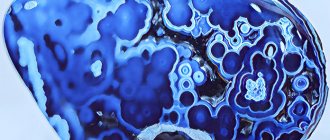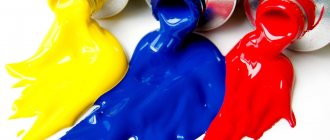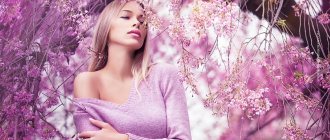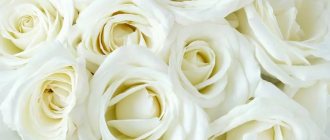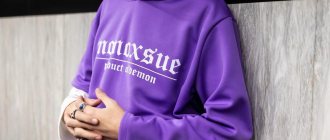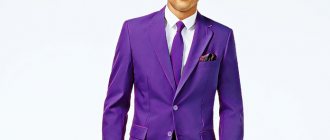The first associations that blue color evokes for most are the sky and water. Looking at it, it’s like feeling the breath of a cool breeze on a clear summer day. It is believed that the name of this color in Russian comes from the word “dove”. Another version speaks of its connection with the word “depth”.
Visually, blue appears to be a lighter variation of blue. However, from the point of view of physics and coloristics (the science of colors), this is not entirely true. Light blue is a mixture of blue and green in different proportions. A huge number of sayings and catchphrases are associated with this shade. It can be called one of the most mysterious flowers, and we will try to reveal all its secrets in this article.
The meaning of blue color in psychology
The ability to have a calming effect on the human body has led to the fact that this color is often used by psychotherapists when working with aggressive and hot-tempered patients. It is easily perceived, helps to relax, improves intuition.
For men
All heavenly shades are preferred by romantic men. Their mood may change frequently, and sometimes they are overly restless and fussy.
For women
Women who prefer this color are purposeful and selfless. They are always ready to defend their opinion.
If such colors predominate in a girl’s clothing, then it indicates her high spirituality, seriousness and ability to achieve her goals.
Being in a room painted in shades of blue helps a woman relax, calm down internally and extinguish unnecessary emotions.
For children
This color is associated with freshness and lightness, therefore it has a positive effect on the fragile child’s psyche and body. Such shades help the child calm down and relieve stress after a stormy day. Don't get too carried away, because... oversaturation with this tone leads to a feeling of coldness and alienation.
Color recognition engine
For a clearer understanding of the impact of color on your psychological and physiological state, let’s figure it out: “How exactly does the color recognition mechanism work?”
The vision of color, or, more precisely, the sensation of color occurs due to the fact that in the retina of the eye there are receptors called cones, capable of responding to electromagnetic radiation. The central parts of the retina are the most saturated with these color receptors. In humans, there are three types of cones, which differ in their spectral sensitivity:
- conditionally red;
Psychology of blue
- conditionally green;
- conditionally blue.
Natural shades and pigments
This color is rarely found in nature.
It is most common among minerals, precious and semi-precious stones:
- larimar and aquamarine - stones come in both blue and greenish colors;
- topaz, it acquires this color due to the presence of titanium ions in its composition;
- turquoise, most often it has a greenish tint, but depending on the place of origin, blue specimens are also found;
- lapis lazuli, this mineral is most often blue, but occasionally blue stones are also found.
It is believed that all stones of this color have healing properties and have their own meaning.
Unique turquoise stone.
Wave of color
Photo by Yaroslav Shuraev: Pexels
In its natural state, the world around you is colorless, that is, color, as such, does not exist in nature. It is a product of how your brain works to process different frequencies of electromagnetic waves.
In physics, there is the concept of a color wave, that is, it is a certain spectrum perceived by the human eye, which, when reflected from objects, gives it the corresponding color. It is the wave of color that is quantitatively captured by your eye and converted into color sensations by parts of the brain.
How do you get blue color?
Few ancient civilizations knew how to distinguish between blue and light blue, only the Egyptians knew how to obtain and use these colors correctly. In nature, such a pigment is rare, so representatives of ancient culture called it the color of the sea or sky. The air looks this way because the process of light scattering occurs.
Despite the fact that this color is rarely found in nature, it is often used in various fields: art, industry, etc. For example, to obtain fine porcelain with the required shade, the Chinese added bluish cobalt to the clay.
Europeans combined oxides of iron, copper, and calcium and as a result obtained blue pigments. They were used in painting churches, creating stained glass windows, etc. In the 19th century learned to make synthetic pigment, which was cheaper and more accessible.
When creating this shade, we must remember that this is a tone of weak saturation, so add a blue color to the white paint. The result is the desired color, which will vary depending on the proportion. Classic blue is formed by mixing equal parts of blue and white paint.
Blue lovers
What color a person likes can tell a psychologist a lot about his personality. The psychological portrait of a person who loves blue includes the following features:
High intellectual potential. Balance, restraint in expressing feelings. The ability to reason soberly even in a tense situation, following the voice of reason rather than the heart. Personality harmony, self-confidence. Developed intuition, insight. Strong and decisive character, dedication, effectiveness. Non-conflict, ability to find compromises. Tendency to meditate, reflect, and withdraw into oneself. Closedness, but within reasonable limits. Limit your circle of friends to a few truly close ones.
Fans of this color have excellent creative abilities and an aesthetic perception of the world. They prefer peace and quiet rather than noise and fun.
Negative traits of blue lovers are impressionability, vulnerability, painful reaction to criticism, sometimes gloom and despondency, melancholy
By profession, people who like this color are often associated with the sea or sky. They often become pilots, flight attendants, sailors, air traffic controllers, or serve in the Navy or Airborne Forces. Their developed intelligence often forces them to try themselves in science and research. And those who have a stronger creative streak become artists, musicians, clothing, interior, and landscape designers.
Physiological effects of blue color on humans
Any color has its own physiological effect on a person. If you suddenly start liking shades of this tone, it may be a sign of stress and fatigue, indicating that rest and relaxation are needed.
This color helps to calm down, but unlike other cold colors, it does not cause inhibition. A person looking at such a palette reduces temperature, mental stress and relaxes muscles, which leads to increased resistance to stress.
Positive influence
For most people, blue and its shades have a positive effect, so they are often used in the design of educational institutions to increase creativity and creativity in students.
For example, lavender and cornflower blue colors have a positive effect on the thyroid gland, helping to more effectively fight high blood pressure and various inflammatory processes. Turquoise, it is used in the treatment of mental patients.
The following positive qualities of this color are noted:
- reduction of irritability, aggressiveness and dissatisfaction;
- improved attention and ability to organize thoughts;
- strengthening feelings and activating fantasy;
- correction of the condition of a patient with mental illnesses (neuroses, insomnia, various phobias);
- increasing stress resistance;
- temperature drop;
- decreased heart rate;
- dulling of pain;
- increasing muscle tone.
Blue color has a calming effect on the nervous system.
Negative impact
Here, as in any other case, the main thing is not to overdo it. Some people associate too much blue with coldness and lack of feelings. Such an environment can lead to apathy and indifference. To avoid the described consequences, you need to harmoniously combine colors when decorating the interior.
Emotional sphere
Most people associate this color with the sea and sky, so it always evokes only pleasant and joyful feelings.
Every person should be surrounded by a blue color, because... it helps to calm down, become more loyal and compassionate towards others.
A workplace decorated in this color encourages productive and efficient activity. Athletes often use clothes of this color, which helps them show better results.
What did the blue tint mean in ancient times?
Since ancient times, the color blue has symbolized noble origin. Of course, you know the concept of “blue blood”, which flowed in the veins of aristocrats.
Some scientists are confident that the beginning of the passion for the blue shade falls on Ancient Egypt: it was there that blue was adored so much that the ancient Egyptians even painted their nails with blue dye. And through this action, they tried to create the illusion of varicose veins, which, as you know, were “distinguished” by a bluish tint. In those days, this disease also indicated a person’s high origin.
Blue (and blue) shades are very close to black and have similar symbolic symbols. For example, in a number of tribes in South Africa, dark blue or dark blue symbolized mourning.
In reality, blue is a combination between white and blue. Based on this, it has a similar effect on the human condition. For example, the shade of the sky copes wonderfully with suppuration and wounds. It also eliminates the fatigue that has accumulated in the body after a hard day at work.
The blue hue symbolizes fidelity, impressionability and affection. Individuals who prefer this color tend to quickly become despondent if any failures occur. In addition, fans of blue always strive for peace, harmony in relationships with others and themselves and are capable of quite thoughtful reflections and aesthetic experiences. They are artistic workaholics who can achieve incredible heights on the career ladder.
Such individuals do not like idleness at all; they are simply crazy about traveling. If you dream of finding a compromise with those who love the color blue, try to be patient enough with them, and your patience will definitely be rewarded.
Attitude to the color blue
No two people are alike, so everyone relates to the specified color in their own way. This will depend not only on the psycho-emotional portrait of the person, but also on the situation in which he finds himself.
If you like the color
People who love this color are often called "artists." This is not related to their type of activity, it implies that they are open, sociable and optimistic. These are dreamers, travel lovers who are not afraid to change their usual environment. Often these are creative individuals, but at the same time they
trying to turn it into a business. There are many fans of this color among scientists who strive to explore the world around them and are drawn to the supernatural.
If blue is unpleasant
There are some people who, due to their character traits, are among those who do not like all shades of this tone.
Features of this category:
- aggressive and unbalanced behavior;
- inability to manage your emotions and words;
- the desire to constantly be on the move;
- making decisions under the influence of momentary emotions and feelings;
- irrationality and lack of composure.
If you like blue: what does it mean?
There is a close connection between a person's temperament and their color preference. That is why blue color can give a detailed description of a person.
- Those who love this color are united by a love of creativity. Moreover, these are not easy hobbies; people strive to turn them into a business and use them to increase their income.
- Azure is preferred by intellectually developed individuals, often working in the field of science. They are eager to know and explore, and gravitate toward the supernatural. Among them are humanists and lovers of technical subjects.
- Those who love the heavenly have an even emotional background, make decisions with a clear mind, rarely relying on the heart and feelings, are always balanced and adequate.
- These are purposeful people, focused on a specific goal, who correctly set priorities in order to achieve the desired results in the shortest possible time. Women who prefer blue devote more time to their careers than to their families.
- Despite the inability to show high feelings and radiate clear emotions, lovers of azure are very vulnerable individuals who suffer failures with pain and can become depressed when a “black streak” appears. Almost all representatives are pessimists and realists.
- Women and men who prefer this color spectrum are perfectionists. This is a deep, perfect shade, like it, people constantly redo something, try and are rarely satisfied with the result.
- They are characterized by antisociality. These are sociable and sociable people who, however, prefer a narrow family circle and quickly get tired of being in a crowd for a long time. They cannot stand loneliness, but they also do not waste time making dozens of new acquaintances.
Symbolism of color
In most world cultures, this color is considered a symbol of calm and peace.
Major religions view it differently:
- Christianity. All Christians are sure that the color of the sky induces humility and piety. The Virgin Mary is often depicted in a blue cloak, and Catholics present her with blue flowers. They symbolize purity, integrity and devotion to God.
- Buddhism. Here this shade is a symbol of motherhood, love and compassion for one’s neighbor. For them, it is associated with harmony, tranquility and spirituality.
- Judaism. All shades of this color symbolize holiness.
- Islam. For Muslims, this color is associated with mourning and sadness.
In ancient Rome, rich people painted blue veins on their arms and legs to emphasize their divine origin.
Christian clergy in colored robes.
LiveInternetLiveInternet
Psychology of blue color. Meaning. Some researchers are of the opinion that the word “blue” originates from the word “dove.” But there is also an opinion that this word is a “relative” of the word “deep” (water conceals, in its depths, a bluish tint). Blue is considered the color of creativity. Therefore, it is recommended to use it in educational institutions.
The "sea" color has no bottom. He knows how to attract the attention of anyone. It intoxicates, calls for a search for meaning and truth. By the way, if you suddenly cannot live without the color blue in your clothes, this means that the energy of imagination is “seething” in you.
Blue color in the psychology of ancient peoples. Since ancient times, the color blue has been associated with noble birth. Surely you've heard of the blue blood that is said to flow in aristocratic veins. Some scientists are of the opinion that it all started with Ancient Egypt: there, the “heavenly color” was treated with such adoration that Egyptian women even painted their legs with blue paint. Thus, they tried to demonstrate varicose veins, which, as is known, “bear” a bluish tint. It is because of this that this disease was considered a sign of high origin.
Since cyan (blue) color is very close to black, both have identical symbolic meanings. Among some tribes of South Africa, for example, dark blue or dark blue was considered a mourning color.
Blue is a “scorching” mixture of white and blue colors. Consequently, it affects the human condition in a similar way. “Heavenly Color”, surprisingly, heals suppuration and wounds. It also relieves the consequences of a difficult day and fatigue.
Blue color in psychology. Blue color is a symbol of fidelity, impressionability and affection. About those people who love this color, we can say with confidence that they easily succumb to despondency during failures. Lovers of blue color prefer peace, strive for harmony with people and with themselves, they have the ability for quite deep thoughts and aesthetic experiences. They are artistic workaholics and, therefore, reach incredible heights on the rungs of the social ladder. These people do not know how and do not like to sit in one place for a long time: travel is their element. If you want to agree on something with people who love the color blue, just show patience and it will certainly be rewarded.
Favorite color is blue. This color is extremely comfortable, it comforts and calms. A lot depends on the state of the blue color: a sense of harmony, depth of feelings, degree of vulnerability. Blue color is an expression of reliability, integrity, trust and loyalty. Many people have come to the conclusion that blue is their Favorite color and it comes from the soul.
One of the amazing properties of blue is its “ability” to expand space. Where there is blue color, or some shades of it, there is a feeling that the passage of time is significantly slowing down. Blue is the color of sensitivity. When you look at him, it seems that he is asking you to look inside yourself.
What does the color blue mean? Some people believe that blue is a symbol of peace. The lady who chooses him knows how to tell the truth, looking into his eyes, and, at the same time, not offend with a word. This happens because she is very confident in herself. Men who choose blue are reserved and cold.
In medicine. It has a blue color and medicinal properties: relieves headaches, refreshes. Blue color is simply a “salvation” for those who are trying to lose weight: it helps reduce appetite. It also helps those with high blood pressure: if you believe in the effectiveness of color therapy, then it can also reduce blood pressure. Also, blue color is useful for those who suffer from insomnia. It helps with diarrhea, vomiting and heartburn. For women: neutralizes PMS and reduces the amount of bleeding during menstruation.
The negative thing about color is that sometimes, “unintentionally,” it can bring a person to melancholy and make him sad. The negative aspects that the blue color “infects” are: the inability to maintain contact with others for a long time, a skeptical mood in planning goals, constant, unremitting dissatisfaction with what is and is happening at the moment.
This color is indispensable for shyness, fear of communication and self-consciousness. A person who is interested in meditation should also remember about the color blue, as it helps to “go into oneself” and be left alone with one’s innermost thoughts. Therefore, if you want to do (or are doing) meditation, light and place a blue lamp or candle nearby.
Psychology of blue color in a person’s profession. What professions do lovers and lovers of blue choose? Those who are in any way associated with risk (for example: military, firefighter, pilot).
People who choose this color are distinguished by win-win intuition, incredible determination and determination. And those who do not feel sympathy for this color, or reject it altogether, dream of serious changes that can relieve depression and stress.
American psychology. At Harvard, doctors conducted an experiment. People were divided into several groups. One of them was left overnight in a room that was illuminated in blue, and the other in green. It turned out that the “residents” of the green room do not feel as comfortable and good as those who spent time in the next room (with blue lighting).
Blue color is “born” for timid people who feel fear. There is no need to allow the color blue to be too much, since its excess will certainly lead to scandals, quarrels and manipulation of people. By the way, legends say that a too “flashy” blue color puts a person in a state of horror, causing ghosts and spirits.
Those who persistently reject the color blue acutely feel a lack of teamwork and friendships. Such people are weak, ambitious, but striving for superiority. Quite often, the blue color is strongly rejected by people suffering from nicotine addiction and by those who are not truly understood by their loved ones.
In Byzantine aesthetics, blue and cyan colors denoted incomprehensible divine secrets (the eternal truth of the transcendental world).
In Kabbalah, this color means gratitude. The Kabbalistic blue sacred triangle with the Eye of Providence appears in Freemason lodges as a sign of ethical communion with the world. Blue emphasizes peaceful principles.
Blue was considered the national color of the Persians and Turks (they believe that the color protects against the evil eye and promotes prosperity). For example, carpets on the floors of mosques and Muslim homes often contained elements of a pure blue (but not green) tone. At the same time, in the medieval Arab world, turquoise-blue tones of jewelry were not used in the robes of kings, since these colors reduced respect for them.
In Ancient Egypt, the color of the sky goddess was canonically blue. The sacred lotus was also blue as a symbol of the feminine-earthly womb. Nefertiti was usually depicted wearing a blue tiara; dancers, according to surviving documents of Ancient Egypt, in blue transparent clothes, which obviously emphasized the purely aesthetic (subconscious) nature of the actions depicted. Egyptian women painted their legs with blue paint, as if imitating varicose veins, which “bear” a bluish tint (this disease was considered a sign of high origin).
In India, this color means truthfulness. Brazilians with the color blue symbolize sadness.
Among the Arabs, blue is the most expressive color, since it is “the color of the material heavens, which support the stars in their places.”
Among the ancient Chinese, blue (blue) was a sign of mourning, but at the same time a symbol of Tao. The Sacred Path, the principle of existence.
Since the 17th century in Europe, the term “blue brigade” has been used to designate selected or privileged mercenary troops. The history of units with this name is not simple. Almost immediately after World War II, the United Nations was founded. Since the 60s, UN troops began to be designated blue, which is associated with the color of the UN flag and the helmets of UN military contingents. As a fact: intelligent humanity has adopted blue as its color (that is, the dominant of the female believing subconscious) as the color of peace on Earth.
Oddly enough, blue was originally considered a feminine color. Virgins, saints, and princesses wore it. Just as red was considered masculine: the color of kings, Jesus Christ, emperors. Despite this differentiation, children were always dressed in white. In the 20th century, the Impressionists created a rich riot of pastel colors and these colors were soon recognized as ideal for children. In accordance with the fashion of that time, girls were dressed in blue, and boys in muted red, that is, pink. This was the case before the world wars. Then sailors and pilots began to dress in blue. Association with military heroes changed the meaning of the color. Now blue symbolized strength, courage, masculine qualities and for boys it became a symbol of a real man. Today we don’t even think: if it’s a boy, we wear blue, if it’s a girl, we wear pink.
When exposed to blue, a person's muscle tension and blood pressure decrease. Breathing becomes less deep and slows down. The frequency and strength of the pulse decreases. Functional psychology calls blue “rising above the passions” or “frigid-sterile.” It is recognized that the owners of blue underwear are incorrigible idealists, full of sublime thoughts;
In color therapy, the analgesic property of blue color is used (headaches, rheumatic pains, PMS pain and reduces the amount of bleeding during menstrual periods). From a physiological point of view, this color is responsible for the immune system. It controls the growth and formation of immunoglobulin proteins, which neutralize toxins and participate in the destruction of foreign viruses and microbes. Therefore, when applied topically, it has an antiseptic effect. Effective in inflammatory processes, reduces suppuration of wounds by stimulating leukocytes. Blue color is also used in the treatment of cancer ("tightens" tissues and fibers and prevents the growth of tumors).
Blue tones of clothing are recommended for skin diseases, allergic reactions, and liver inflammation. Blue colors of dishes and tablecloths significantly reduce appetite; the color is used as a means of weight loss and an effective anti-emetic agent.
In psychiatry, it is recommended to weaken nervous attacks during manic states and to dispel obsessions. An example is a device for insomnia sufferers that emits soft blue light.
It is believed that women wearing blue clothes look younger because blue gives them freshness.
Blue color relieves fatigue.
The color is compared with the color of peace, concentration, goodwill, and the ability to get along with people. Blue color promotes better assimilation of information and the establishment of friendly relationships, so it is recommended to be used in meeting rooms. (And, it would seem, blue, which is close to it, on the contrary, distracts attention and reduces the efficiency of staff).
Blue, as pleasure, means peace, contentment, harmony; as displeasure, it means restraining peace, mortal boredom, dissatisfaction. This is the ideal of unity and harmony, a symbol of primordial maternal affection, fidelity, and dedication. This color is extremely comfortable, it comforts and calms.
https://sunhi.ru
Series of messages “Psychology of Color”:
Part 1 - psychology of color. blue Part 2 - color psychology. red... Part 4 - Gray Part 5 - And purple for me Part 6 - Blue in our lives Part 7 - Black post. I haven’t made colored ones for a long time Part 8 - Something is purple for me today... ... Part 20 - Purple... Part 21 - WHY IS THE COLOR PURPLE NOT USED ON COUNTRIES FLAGS? Part 22 - Little-known facts about colors
Geography of blue - widespread use in home decoration
This color is often used when decorating houses, but it must be taken into account that its meaning varies in different countries. For example, in China this shade means immortality, in America it is associated with masculinity, in Japan - with deceit and meanness.
In Morocco, windows and doors are painted this color, because... it is believed to protect against evil spirits. This country is home to the bluest city on Earth - Chaven. Here, most of the houses are painted cobalt.
The positive influence of blue on a person’s psychological state is often used when decorating houses.
A siding roof of this color not only looks beautiful, but when people look at it, their blood pressure, breathing and muscle tone normalize. A house decorated in such colors is well suited for creative and romantic people.
When choosing this option, it is necessary to take into account that on a hot day, this design gives a feeling of coolness, but during the cold period it increases the feeling of chilliness, so you should not overdo it when using it.
Decorating a home in blue tones has the following advantages:
- visually strengthening the walls of the house, giving them grandeur and monumentality;
- reflection of sunlight, which is especially important in the southern regions;
- combination with bright and rich colors;
- slow fading in the sun, so the house retains its attractive appearance for a long time.
The effect of blue on health
Color therapy is a method of alternative medicine in which a colored color is applied to the patient in a certain way. Blue is popular in this area due to its abundance of beneficial properties.
Benefits of blue for physical health:
Slows down breathing and reduces heart rate. Reduces blood pressure, helps prevent heart and vascular diseases. Prevents sleep disorders. Reduces muscle tone, relaxes muscles. Acts as an analgesic, including for rheumatism, headaches and menstrual pain. Relieves inflammatory processes in the body. Improves the condition of the digestive system, relieves heartburn and diarrhea. Facilitates well-being with sore throat, measles, burns, allergies. Relieves visual tension.
Mental Health Benefits:
Reduces emotional stress, relaxes.
Relieves obsessions. Relieves nervous attacks. Prevents attacks of hypochondria. Restrains attacks of aggression and neuroses. Finally, color perfectly stimulates intellectual activity, improves thinking and memory, promotes the development of imagination and flight of fancy.
Researchers note that blue color is useful to “inhale.” To do this, you need to collect blue flowers and put them in a vase in the bedroom, next to the bed.
Using the color blue in healing meditations
This color helps in the treatment of various diseases. It refreshes well, relieves headaches, and reduces appetite, which is important for those who want to lose weight.
According to experts who practice color therapy, shades of this tone help reduce blood pressure, normalize sleep, and get rid of heartburn, diarrhea and vomiting.
For women, wearing this design reduces the amount of bleeding during menstruation and neutralizes PMS symptoms. It helps overcome shyness and self-consciousness.
Color healing has been used for a long time, dating back to the formation of Persia, Egypt and China. Each tone has its own effect on the body. Being in a room painted in blue tones helps fight thyroid diseases, activates sweating, lowers body temperature, which leads to the elimination of waste and toxins.
In medical practice
Blue color also has healing properties: for example, it successfully copes with headaches and can refresh. Another blue tint is a real “salvation” for anyone who wants to lose excess weight, as it reduces cravings for food.
It is recommended to seek help from the blue tint for people suffering from high blood pressure: if you believe that color therapy really helps, then it will help you lower your blood pressure. Also, with the help of a blue tint, you can really eliminate insomnia. Also within its sphere of influence are diarrhea, vomiting and heartburn.
For representatives of the fair sex, this shade will help cope with the consequences of premenstrual syndrome and will make bleeding less profuse during menstrual periods.
The negative point is that color can inadvertently provoke melancholy in a person and cause a feeling of sadness. In addition, the blue tint fills with the following negative aspects: the inability to maintain contact with other people for a long time, a skeptical mood regarding long-term planning of goals, constant unabating dissatisfaction with what is happening at a given time.
If a person is shy, afraid of communication and very self-conscious, he definitely needs to turn to the blue shade for help.
It is also an indispensable tone for all those who practice meditative practices, as it promotes “immersion in oneself” and being alone with one’s secret thoughts. For this reason, if you wish to (or already practice) meditation, you must use a blue or blue lamp and candle.
Interesting facts about the color blue
This color has many shades, it evokes pleasant associations, so it has quite a lot of fans.
Some interesting facts about him:
- Blue and its shades are the favorite color of almost half of the entire population of the planet. It appears on many national emblems and flags.
- In Ancient Rome, this shade was a symbol of deceit and was associated with troubles. People with blue eyes were considered inferior. In Ancient Egypt, on the contrary, this tone is a symbol of noble origin.
- The familiar color of the sky is associated with an effect called Rayleigh light scattering. Blue waves are shorter in length than red ones, causing them to spread more widely.
- Morpho butterflies have blue wings. This is achieved not due to pigment, but thanks to the scales through which sunlight is refracted and such an illusion is created.
- It used to be that aristocrats had blue blood. This is a metaphor for people, but some mollusks have blood of this color. In the octopus, this color is given by the pigment hemocyanin.
Beautiful Morpho butterflies.
Origins
Most language researchers agree that “blue” is derived from the word “dove.” The bluish color of this bird is one of the most pleasant shades of blue combined with gray. According to another version, the name goes back to the word “depth”.
The color is a combination of deep blue and crystal white, sometimes with a shift towards green. Interestingly, blue tint is rare in nature. For example, a cloudless sky does not have this hue at all, but appears blue due to the scattering of ultraviolet rays. And sea waters are often clear, not blue. In nature, blue and its shades are found among minerals and precious stones: sapphire, topaz, lapis lazuli, aquamarine and spinel.
Blue tones
In its pure form, this color refers to cold tones, but if you add a little yellow to it, it acquires a warm tint.
Cold
Basic cold tones: protective blue, cornflower blue, azure, etc. They have a metallic tint and are dark in color. People who prefer such colors strive for variety, new adventures and self-improvement. They are characterized by a passion for religion and meditation, and they often become sailors or military men. Such people strive to get the most out of life.
Warm
The warm tones of this color include heavenly and all its varieties. Preference for light, pastel colors indicates a sociable and open character.
Such people cannot stand loneliness; they suffer from depression, boredom and a feeling of emptiness. Lovers of the warm tones of this color scheme have many friends with whom they are always ready to share their material and spiritual values.
Variation of characters depending on tone
All people have their favorite color. Some people like two or three different shades. Using them, you can give a certain characteristic of a person, find out hobbies, goals and mindset, level of emotionality. Therefore, it is important to know what the color blue means and symbolizes. Those who like him are very bright and impressionable people who have managed to preserve their childlike spontaneity. They are prone to carelessness, sudden changes in mood, they can be very happy, and after a minute they become despondent and bored. They are characterized by a change of place, a desire to change the environment. They are capable of strong, sincere love and experience true happiness and satisfaction.
This is the color of creative and creative individuals, and not necessarily actors, artists or pop performers. These are playful, passionate men and women who strive for success, recognition and creating beauty around them. The shades of the heavenly can tell more precisely:
- Light, pastel colors indicate sociability and openness. Those who prefer it do not like loneliness, often suffer from feelings of emptiness, boredom and depression. They have a large social circle, where they give everyone maximum attention, both material and spiritual.
- Cold, metallic, dark characterize the attraction to diversity, self-improvement, new cities and countries. People are interested in everything unusual and even mystical. They can fall into religion or go high into the mountains for meditation and yoga, or choose the profession of a military man or sailor. They take everything from life, bathe in luxury and recognition.
All bluish shades distinguish self-sufficient people who know themselves well, know how to control, say “stop” at the right moment, and strive for harmony, order, silence and stability. Those who do not like this color crave change and constantly live in anxiety.
Psychologist Daria Milai
Make an appointment
Shades of blue
The whole variety of warm and cold tones is divided into a number of shades, among which the most popular are:
- pale blue is the lightest shade, the white undertone dominates here, which has a positive effect on the psyche and has a calming effect;
- steel blue - it is close to purple, but has a bluish tint, is actively used in interior design, and is a symbol of determination;
- light glaze is a symbol of wisdom and infinity;
- turquoise – refers to deep warm tones, personifies purity and innocence, uplifts the mood;
- cornflower blue is pale, its undertone is the most delicate of the palette of this color, it is associated with romanticism and lightness of thoughts;
- cobalt - named after the corresponding metal, symbolizes confidence and harmony;
- lavender - personifies mystery, tenderness and mystery.
How many of them exist in different palettes
There are 119 shades of blue in the Pantone system. Using the appropriate table, you can find your favorite shade and find out its correct name. This will help expand your understanding of the diversity of this color scheme, and the knowledge gained can be used at your discretion.
There are several popular color models (mathematical system), with the help of which all shades are encoded differently:
- RGB (Red, Green, Blue). Here different amounts of these colors are added to black. The heavenly shade is obtained using 11% red, 67% green and 84% blue. In RGB, everything is counted in absolute values (from 0 to 255), it turns out that this color is designated as rgb (28, 170, 214).
- CMYK (Cyan, Magenta, Yellow, Key). In this model, any shade consists of a combination of blue-green, purple and yellow. Here, different numbers of the described colors are subtracted from white. Celestial includes the indicated colors in the following ratio: cmyk (86%, 20%, 0%, 16%).
- HEX – hexadecimal model. Here the designation consists of numbers from 0 to 9 and letters from A to F. The 6 symbols used in pairs are responsible for the red, green and blue color. In this system, celestial is designated as 1DACD6.
- HSV - in this system, color is described as light of a given hue and saturation. Heavenly is designated as hsv (194, 0.86%, 0.84%).
- HSL - color description occurs as light belonging to a given tone. In this case, celestial would be written as hsl (194, 76%, 48%).
All shades of blue.
Pastel shades
Such tones are also called pale or muted: steel, gray, pale blue, etc. They have a relaxing effect and are often used as a background.
Bright colors
They differ in saturation; the most common colors are azure, turquoise, topaz. They help create a festive and joyful atmosphere.
Dark shades
You have to be careful with them, because... an overabundance of dark tones can cause a feeling of dejection. When decorating a room painted in dark colors, only certain items can be present.
Characteristics of blue
So, if color is a sensation, then it has a direct effect on the psychological and physical state of a person. Let's stick to blue. Technically, blue color can be described by the following characteristics:
- the range of electromagnetic wavelength corresponding to this color lies in the range of 480-460 n/m;
- a group of shades of blue with a slight shift towards green, or simply light shades of blue: intermediate between blue and green;
- based on its stimulating effect, it belongs to the group of calming or inhibiting stimulating effects of red, orange and yellow.
Combination of blue with other colors and shades
When combined with other colors, you get gentle and inspiring solutions. This shade helps reveal dark colors better and allows you to create different combinations.
Pink
The result of this combination is warm, gentle and light tones. The expressive and rich palette includes white-lilac, raspberry, cloudy or sunset pink.
Orange
This combination is based on the contrast of blue and orange. Unlike blue, the sky shade softens this difference, so you get a harmonious and attractive composition, for example, peach, coral, tangerine, yellow or red-orange.
Red
This pair allows you to create seductive combinations. The contrast of warm and cold tones makes the heart beat faster. Against the background of blue, red looks bright and the darker it is, the higher the light contrast and the lower the thermal contrast. Resulting colors: garnet, ruby, wine, coral red.
A clear combination of red and blue.
Yellow and gold
These colors create a natural combination that is inspiring and energizing. It is possible to create the following shades: banana, apricot, amber, bright or yellow-gold.
Gray and silver
This is a classic variation. Against a gray background, blue dominates. To get a good result, you should use not pure gray, but its more complex tones. When decorating an interior, objects are most often painted gray, and trim is blue.
Green cold and warm
Paired with warm greens makes a joyful combination. These are related tones, so combining them allows you to create light and warm solutions. These include: brown-green, pistachio, chartreuse, marsh.
Cool green is more of a shade of blue. When combined, it is possible to create additional volume.
This palette is used independently and acts as a background for warm tones. The result is malachite, jade, emerald colors.
Blue
This solution makes it possible to obtain a monochromatic range, where blue acts as a highlight and blue as a shadow. The darker the colors combined, the brighter the contrast. Such solutions include cobalt, turquoise, electric, and Prussian blue.
Violet
When this color and purple are combined, a cool and mysterious range is obtained. The thermal contrast will be light and unobtrusive. The following compositions are created: grape, violet, amethyst, purple.
Beige and brown
Paired with brown makes a unique and attractive pairing. Warm earthy color and heavenly shade are two opposites, so they complement each other well. These are colors such as bronze, coffee, chocolate, mahogany.
Beige is a neutral color, which allows it to be combined harmoniously with blue. Beige in such a composition looks more feminine and graceful, it acquires a golden color.
White and black
Blue and white are the most popular combination. This color has a calming and relaxing effect, so it is often used in interior design.
The combination with black is bold and risky. It is appropriate for a strict business design or when designing evening sets.
The most delicate combination of white and blue.
Impact on the psyche
The blue color evokes spiritual harmony, gives vigor and confidence in any difficult life situations. Sky blue is considered to be the color of hope. It promotes a positive attitude. Helps to believe in the best, reveals spiritual potential, hidden opportunities to combat emerging problems. When meditating, blue tones help clear the mind of harmful thoughts and emotions. Psychologists recommend using shades of blue when it is necessary to resolve complex issues. This color helps to get rid of excessive shyness, uncertainty and confusion.
Blue color has a beneficial effect on human creativity. Therefore, psychologists advise using a similar color scheme in educational institutions, various institutions of additional education for children, etc.
Blue predisposes to the development of intellectual activity and promotes the generation of new ideas. It is enough to just concentrate your attention on a blue stone or a painting with a predominance of blue shades for 15 minutes to get out of a state of creative crisis.
However, it is worth noting that an excess of blue can lead to melancholy, depression, prostration and the manifestation of misanthropy. There is a psychotype of people in whom bluish tones cause depression, a depressed state, and negatively affect their ability to work. They are distinguished by such character traits as excessive impulsiveness, instability, aggression towards others, and a decrease in the ability to self-control. This personality type is characterized by hyperactivity; they are often guided by emotions rather than reason.
In such a case, you should “dilute” the blue palette with additional colors: white, orange, green, brown, gold, anthracite.
The use of blue color in the interior
When using this tone in the interior, consider the following:
- all rooms associated with water, such as a bath, shower, sauna, toilet, swimming pool, etc., look good in blue design;
- the relaxing effect of such shades allows them to be used when decorating relaxation rooms;
- when decorating a room facing the sunny side, this solution will help reduce the feeling of heat, stuffiness and relax;
- If you decorate a cafe in this color scheme, women will love it, because... the color is associated with sweets, desserts must be on the menu;
- When decorating sports rooms, you need to carefully use such colors, because... they slow down the psyche, cause laziness, so the effectiveness of classes decreases.
Who is it suitable for?
Blue is the color of intellectuals and creative men and women, among whom were professors, programmers, senior managers, artists, actors, writers and those who made self-improvement the basis of their existence. Blue clothes are a good solution for dreamers and dreamers. A dress will highlight a girl’s refined figure, and a tie or scarf will indicate a man who is watching him. The tone looks best in combination with white and black, light green, delicate peach, beige and cream, bright orange and discreet dark brown.
Ask a question
Use in clothing
Regardless of the combinations used to design clothes, this shade gives the image romance, tenderness and naivety. If a woman wears a lot of blue, she is most often an idealist.
An accessory of this color is suitable for both business and evening style. A monochromatic outfit may look out of place.
For the “spring” color type, light and pure tones are suitable. Grayish shades are optimal for the “summer” and “autumn” color types. “Winter” should use azure and turquoise.
Blue in clothes.
What does it mean, symbolize and what is associated with?
Cyan, a light shade of blue. Quite common in nature , therefore it is perceived by the human psyche as natural and safe.
It has a wide range of shades, the most famous of which are ultramarine, pervanche, turquoise, azure, and sky.
Interesting information about the color blue:
- Orthodoxy is personified by the color blue with the Virgin Mary.
- The common phrase “blue dream” means a beautiful dream that is almost impossible to achieve.
This is due to the fact that blue has long been considered a color that signifies perfection and dreams. - Topaz represents the color blue.
- Blue is the specific gray color of cat fur that is characteristic of certain breeds, for example the Russian Blue cat.
- Blue nevi (moles) are sometimes found on people's skin. They can sometimes be dangerous, but in most cases they are harmless, although they are more likely to develop into melanoma than regular brown moles.
The most common association with the color blue is the sky .
The skies in sunny weather are painted a rich blue color, sometimes fading into blue.
Clear skies have long been considered a good sign, since they did not foreshadow troubles in the form of thunderstorms, hail, or snow that could seriously complicate the lives of people of the past.
A large number of flowers are colored blue, for example cornflower, chicory, scilla, delphinium, forget-me-nots, blue flax, some varieties of plants such as lilac, poppy, bells, petunia, iris, ageratum.
Many people, when thinking about the color blue, will remember Malvina’s hair from the children’s fairy tale “The Golden Key” and her prototype, the Blue Fairy from “Pinocchio”. These two characters serve primarily to push the protagonist towards the light.
Blue color is the personification of peace, hope, goodness, light, intelligence, calm, confidence, happiness, fidelity, security, inspiration, spirituality, dreams, harmony, creativity, wisdom and the desire for knowledge.
This is a light and cozy color that rarely evokes negative emotions in people.
What does the color blue mean in psychology? Find out about it in the video:
Blue color in advertising
Such shades are actively used in the design of websites, search engines and other software. This is due to the fact that they do not cause irritation.
This color scheme is often used in various advertising campaigns. This color is associated with boys and young men, and is therefore used in advertising toys and clothing for them.
To avoid boredom and monotony, blue is often combined in advertising with white, red or black. This tone is associated with cleanliness, so it is used when painting bed linen, toys, rugs, etc.
Peculiarities of perception
Most people associate blue tones with peace, serenity, and euphoria. Images of heavenly heights, clear and cloudless, appear in the imagination. Since ancient times, the concept of clear skies has symbolized a good omen.
What is the meaning of blue color in psychology? Cool shades of blue have a calming effect on a person’s state of mind and evoke peace. The so-called “soft” blue tone has the most beneficial effect on the psyche.
Blue color in the interior is an ideal solution when decorating a bedroom - it helps reduce irritability, fatigue, healthy and restful sleep.
Also, azure tones are perfect for the living room. In such a room, people feel relaxed and do not experience tension in communication.
Blue shades work well when decorating a bathroom. They promote physical and mental relaxation. Blue color evokes a feeling of safety, stability, security. In such an environment, a person is prone to self-reflection.
When decorating the kitchen, you should refrain from blue tones, as they help suppress appetite.
It is worth noting that some people associate azure tones with coolness, which entails passivity, inaction, inertia, and reduces the stability of attention.
Blue tones encourage trust and respect. If you have an unpleasant meeting, psychologists recommend wearing blue clothes. Such a trick helps smooth out conflict situations and has a calming effect on the emotional state of the opponent.
Blue color is also widely used in the design of various Internet sites. Bright blue color stimulates the development of creativity and thinking in users, and evokes a desire for knowledge. It does not cause negative emotions such as irritation, indignation, and anger.
Blue color is widely used in alternative medicine. It is used to relieve headaches, lower blood pressure, and normalize heart rate. It is generally accepted that the colors of sky blue help in the fight against insomnia, indigestion, nausea, heartburn, help improve the condition of infectious diseases, and relieve itching.
When carrying out color therapy, a beneficial effect of blue tones on the functioning of the immune and respiratory systems, muscle and bone tissues is observed.
What does dislike of color mean?
Certain character traits are also present in those who dislike blue , such as:
- Aggressiveness, imbalance. It is difficult for them to control themselves, they easily explode and cool down just as easily. Such people are overly active and strive to do as much as possible.
- Impulsiveness. They quickly make decisions, guided by emotions rather than reason; they can hardly be called rationalists.
Also, people who do not like the color blue are falsely called dreamers .
What does the color red symbolize? Find out the answer right now.
